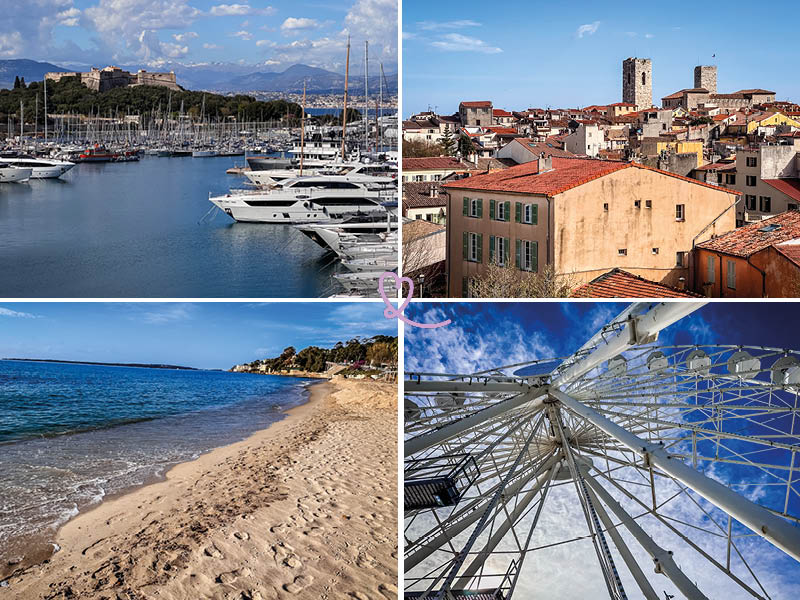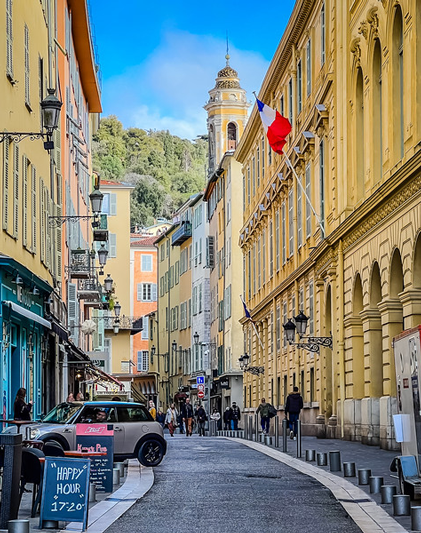Is Antibes worth a visit? Need some inspiration to plan your weekend or vacation?
Antibes, on the Côte d’Azur between Cannes and Nice, is famous for its beaches and the seaside resort of Juan-les-Pins. But it has much more to offer: rich heritage, museums, water sports and seaside walks, there’s something for everyone! Discover the charm of Provence with a visit to Antibes and its splendid landscapes, which have inspired numerous artists.
In this article, we give you our 10 reasons to go to Antibes, and a few points to keep in mind.

This review is completely independent, based on our experiences. We visited the area anonymously, making our own choices, and paying all our bills in full.
Is Antibes worth a visit?
Antibes, a coastal town in the Alpes-Maritimes, is well worth a visit for several reasons. First of all, we enjoyed the old town, which has preserved its Provencal charm. It’s a pleasure to stroll through this human-sized commune, with its magnificent Mediterranean landscapes. Take the coastal path to Cap d’Antibes and its impressive Garoupe lighthouse!

We also think Antibes is worth a visit for its museums, especially the Picasso Museum. Add to that a rich heritage, such as Fort Carré, or Port Vauban, Europe’s leading marina!

Last but not least, it’s an ideal place to relax: numerous beaches, water sports and leisure parks. In Antibes, you’ll immediately feel like you’re on vacation!
Check out our upcoming article on the best things to do, see and visit in Antibes!
WHERE TO STAY IN Antibes
Option 1: near the ramparts
Close to the ramparts, to enjoy the charm of the old town and all the restaurants.
Hôtel la Villa Port – See prices, photos and availability
On the beach side (Ponteil and Salis) with views of the ramparts and mountains.
Hôtel La Jabotte – See prices, photos and availability
In Juan-les-Pins, in the heart of the peninsula.
Hôtel La Villa Cap d’Antibes – See prices, photos and availability

Reason 1 – For its historic center
In love with Provencal charm? You’ll find what you’re looking for in the old town of Antibes. Surrounded by 16th-century ramparts, we were seduced by the colorful alleyways dotted with plants, cobblestone pavements and shopkeepers.

Take a good look around you! Architectural details, such as niches housing sculptures, are hidden throughout old Antibes!

In addition to rampart gates such as the Porte de l’Orme, pretty squares such as the Place Nationale and its former herbalist’s shop, you’ll be able to see a beautiful washhouse, the Tourraque, the only one still standing today.

Reason 2 – For its rich heritage
We’ve already mentioned a few elements of Antibes’ heritage. It’s true that most of it is concentrated in this part of town. This is where you’ll find religious buildings that are well worth a visit. Why not admire the frescoes in the Chapelle Saint-Bernardin and stop off at the Cathédrale Notre-Dame de l’Immaculée Conception? As far as we’re concerned, we weren’t disappointed with our visits!

But it’s as you leave the old town that you’ll discover Antibes’ most famous monument: Fort Carré. Next to Port Vauban, this is one of the first bastioned forts built during the Renaissance. It dates back to the 16th century, when Henri II, King of France, needed a sentry to watch over the border with the Duchy of Savoy, then occupying the County of Nice. Known for its star-shaped architecture and 4-hectare park, which impressed us, it’s a must-see!

A LITTLE MORE patience
All the photos, maps, information, good addresses to make your stay in Provence a success, will soon be gathered in a single ebook!
If you wish to be informed of the publication of our guide on Provence, subscribe:

Reason 3 – For its many museums
Antibes is home to a number of museums, including the Musée Picasso since 1966. It is housed in a 14th-century castle, formerly the residence of bishops in the Middle Ages, a Roman castrum, and the acropolis of the Greek city of Antipolis. The Musée d’Antibes was opened in 1925, and in 1946 Pablo Picasso moved his studio there at the suggestion of the curator, before returning to Paris. Productions from this period formed the basis of the museum’s collection, which was subsequently enriched by works by other artists such as Joan Miró, Bernard Pagès and Nicolas de Staël. We were delighted to rediscover these great names in contemporary art!

The town also boasts a number of unusual museums. We went back to childhood at the Musée de la Carte Postale and the Musée Peynet et du Dessin Humoristique!

We then learned a lot about the city’s ancient history at the Archaeology Museum. Housed in the Saint-André Bastion, built by Vauban at the end of the 17th century, this museum presents objects from underwater and land excavations that we found fascinating! Finally, Antibes is home to the Musée de l’École, but as it’s only open at weekends, we weren’t able to visit.

Discover our article on the best museums in Antibes.
OUR TPS FOR RENTING YOUR CAR IN Provence
- Compare prices on our preferred platform: DiscoverCars – one of the best rated sites.
- Choose a car that is powerful enough (the roads are steep) but compact (some passages are narrow).
- Think of thecomplete insurance (some roads are tortuous and narrow).
- There is a lot of demand, book it early.

Reason 4 – For its beaches
Do you prefer fine sand or pebble beaches? There’s no need to choose, you’ll find both types of beach in Antibes! Head north to Fontonne Est beach for pebble lovers. For the others, there are several possibilities. First of all, there’s the little beach of La Gravette, just outside the old town. For more space, we recommend the Salis and Ponteil beaches. If you prefer a wilder environment, head for Cap d’Antibes!

Antibes is also famous for its seaside resort of Juan-les-Pins. These include Plage Gallice, Plage des Îles, Plage des Pêcheurs, Grande Plage and the more remote Plage du Soleil. But it’s the little Plage des Ondes with its tower that really stood out for us. Although it looks very old, it only dates back to the 1960s, when the beach was privately owned. It is said to have served as a dressing room for actress Martine Carole, during the filming of “Un Soir sur la Plage” (1961).

Reason 5 – For its nature escapades
We were pleasantly surprised to discover places to recharge our batteries in the heart of nature in Antibes. Our favorite is the Jardin Botanique de la Villa Thuret, which holds 2 labels: “jardin remarquable” and “arbres remarquables”. He richly deserves them! This 3.5-hectare exotic plant acclimatization site dates back to 1857. The visit, punctuated by explanatory panels, allows us to observe a wide variety of species, such as this “Echium nervosum” from Portugal.

If you’re more forest than garden, head for the Bois de la Garoupe! This is the only wooded area on the Cape, protected by the Conservatoire du Littoral. Surrounded by numerous hotels and luxury villas, it overlooks the Salis cove. It offers a refreshing stroll through evergreen oaks, leading to the Chapelle du Calvaire, then to the Église Notre-Dame-de-la-Garoupe.

Reason 6 – To enjoy Cap d’Antibes
We couldn’t fail to mention Cap d’Antibes. This wooded peninsula dotted with villas and luxury hotels separates Antibes from its seaside resort, Juan-les-Pins. Here we find the Bois de la Garoupe, which we mentioned earlier, as well as the Plateau de la Garoupe, some ten metres higher up. In addition to the Calvaire chapel, we were able to admire the beautiful Garoupe lighthouse. Thanks to an orientation table, we were able to make the most of the panorama of old Antibes and Cannes!

While Cap d’Antibes can be reached by car via the Route du Phare, we recommend taking the time to discover it on foot, via the Tirepoil trail. This coastal path offers a 2-hour stroll (approx. 5km), from Garoupe beach to the Baie des Milliardaires. Along the way, you’ll see some superb coves and enjoy breathtaking views over the Bay of La Napoule. On the other hand, as the name suggests, it’s a windy walk!

Subscribe to our Newsletter
- Get away from it all with Region Lovers’ beautiful destinations!
- Once a month
- Advertising-free
Reason 7 – For its gastronomy and excellent restaurants
In Provence, there’s one thing you can’t do without: the market! Take advantage of your trip to Antibes’ old town to discover its Provencal market, in a charming covered market hall. Spices, vegetables, honeys, jams and wicker baskets – our senses were on alert!

After our many walks, we pampered ourselves at the 1-star Le Figuier restaurant in Saint-Esprit. We opted for the 8-course discovery menu, and although we were full, we weren’t disappointed! For example, we tasted a succulent foie gras with a pear chutney and acacia honey emulsion. The setting was also enchanting, with a tree adorned with garlands.

Read our article on the best restaurants in Antibes.
Reason 8 – For its nautical activities
Antibes, with its many beaches and coves, is an ideal place for water sports. In addition to boat trips, you can try snorkeling, diving or even freediving! Antibes’ waters are rich in fish of all kinds. If you’d rather work off some energy, opt for a sea kayak trip!

See all water sports activities in Antibes.
Reason 9 – For its leisure parks
You’ll be spoilt for choice when it comes to entertainment in Antibes. We recommend a ride on the Ferris Wheel at Port Vauban. We didn’t hesitate to fall back into childhood, and we were right to do so! From up here, the view of the old town and Fort Carré is breathtaking. If you’re with the family, we recommend you take advantage of the attractions at Antibes Land, the largest amusement park on the Côte d’Azur. Other parks in the same area include Adventure Golf and Kids Island. They belong to Marineland, which we chose not to visit.

Reason 10 – For its proximity to Nice, Cannes and Monaco
Antibes has one major advantage: it’s located between Nice and Cannes. This makes it an ideal place to relax in a community on a human scale, while discovering the major cities of the Côte d’Azur. By TER (regional express train), it will take you 20 minutes to get to Nice and 1 hour to reach Monaco. A ten-minute TGV train ride will take you to the center of Cannes. However, we recommend that you opt for a car, which will allow you to explore the region to the full.
Here are the main journey times to give you an idea of the distances involved:
- Driving time to Nice: 35min.
- Driving time to Cannes: 30min.
- Driving time to Monaco: 1h.
You can also opt for excursions:
- from Nice, visit Èze, Cannes, Monaco, Saint-Paul-de-Vence, Antibes: see program and availability.
- from Nice, visit Antibes, Saint-Paul-de-Vence, with wine tasting: see program and availability.
- from Cannes, visit Monaco, Antibes and Èze: see program and availability.
These times do not take into account frequent traffic jams. If you’re looking for ideas for activities in Nice, read our dedicated article!

Some disadvantages of a trip to Antibes
Traffic and congestion
Antibes can be very busy, especially during the summer season. If you have the chance, we advise you to go off-season! Because of this influx, and also because this coastline is densely populated, there can be a lot of traffic jams. A 35-minute journey to Nice can be made in 1 hour during rush hour! If you only want to visit the city centers, opt for the train. On the other hand, don’t hesitate to take your car to visit the less-frequented hinterland! Because of this population density, some areas of Antibes can lack cleanliness.

The rates
Visiting the French Riviera comes at a price, some accommodations and restaurants can sometimes seem expensive, especially in high season. We recommend that you book your accommodation and activities as early as possible, and invite you to discover our article on the best hotels to stay in Antibes in the near future.

The weather
Antibes enjoys a mild Mediterranean climate. However, in the summer, temperatures can sometimes rise significantly, which can make outdoor activities uncomfortable, especially if you can’t stand the heat. Do as we do, and visit Antibes and the surrounding area in spring, autumn or winter.

Practical tips for getting to Antibes, France.
Antibes is located in southeastern France, in the Provence-Alpes-Côte d’Azur region.
Our Antibes map will be available soon!
To get to Antibes, you can choose the train option. TGV high-speed trains take you from Paris (5h), Lyon (with TER connections, 5h), Marseille (2h) and many other European cities. Departing from Toulon and Cannes, the short journey is made by TER.
See the available schedules and book your train tickets now.
If you’re traveling by car from elsewhere in France, you can reach Antibes via the A6, the A8, the Autoroute du Soleil, or the national and departmental roads.
If you’re coming to Antibes from Italy, you can take the A10 freeway or the A8 freeway from Ventimiglia.
Finally, if you’re traveling by car from other European countries, you’ll need to plan your itinerary around your point of departure, using European freeways like the A8 or the Italian A10 (or Autoroute des Fleurs).

You can also fly to Nice, which is served by major European cities. You can also rent a car on arrival in Nice at the train station or airport, and drive to Antibes.
Note that traffic can be heavy, especially during peak and vacation periods. We recommend that you check traffic conditions and plan your route in advance. In addition, make sure you have a motorway sticker in the countries concerned, if necessary, and that you respect the Highway Code of the countries you will be crossing.
PLAN YOUR TRIP TO THE Côte d’Azur
- Inspiration
The most beautiful landscapes in 30 photos
Best things to do on the Côte d’Azur
Most beautiful villages
Best beaches on the Côte d’Azur
Most beautiful gardens
Best boat tours (coming soon)
Most beautiful islands
Secret places

- Practical advice
Successful travel on the Côte d’Azur (coming soon)
Rent a car in Provence – in Nice – in Cannes – in Marseille – in Aix-en-Provence.
Itineraries: 5 days – 1 week – 10 days
Weekend ideas: best-of – romantic – luxury – unusual

- Where to stay
Where to stay on the Côte d’Azur
Best luxury hotels on the Côte d’Azur
Hotels by the sea
Best boutique-hotels






